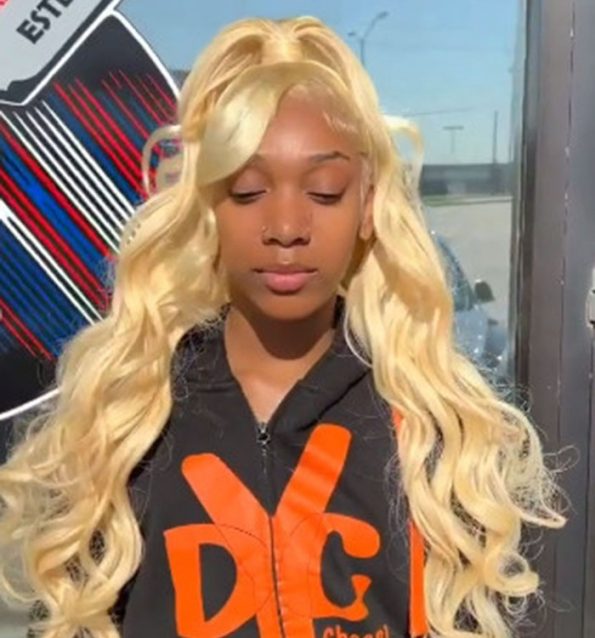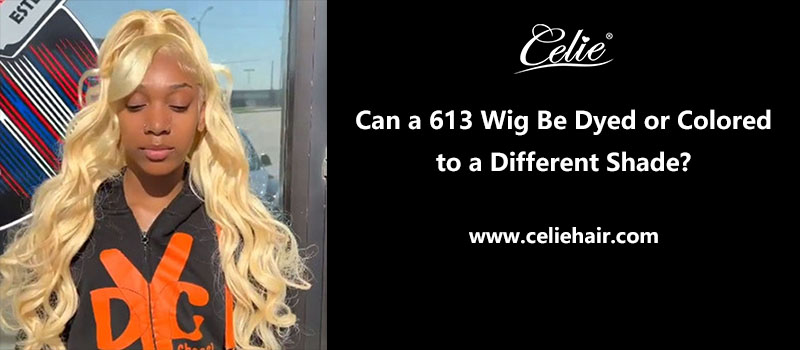The 613 wig, known for its light blonde shade. However, many wig wearers wonder if it is possible to dye or color a 613 wig to a different shade. In this article, we will explore the intricacies of wig dyeing and coloring processes and determine whether a 613 wig can be transformed into a different hue.

The Dyeing Process.
The process of dyeing a wig involves applying color to alter its original shade. However, when it comes to dyeing a 613 wig, there are specific considerations to keep in mind due to its light blonde color. Let’s explore the dyeing process and factors that affect the outcome when attempting to change the shade of a 613 wig.
Wig Quality and Hair Type:
The quality of the wig and the type of hair used are crucial factors that determine the success of dyeing. Higher-quality wigs made from human hair tend to respond better to the dyeing process compared to synthetic wigs. Human hair wigs are more versatile and can be dyed using similar techniques applied to natural hair. On the other hand, synthetic wigs are typically not recommended for dyeing as they are made from synthetic fibers that may not absorb the color effectively.
Preparing the Wig:
Before dyeing a 613 wig, it’s important to prepare it properly. Start by gently washing the wig with a mild shampoo to remove any product buildup or residue. Allow the wig to air dry completely before proceeding with the dyeing process. Avoid using excessive heat or blow dryers, as they can damage the hair strands or alter the wig’s shape.
Selecting the Right Hair Dye:
Choosing the appropriate hair dye is crucial for achieving the desired color transformation. When dyeing a 613 wig, it’s important to consider the current shade and the target shade. Lightening a wig that is already light blonde can be challenging, as the hair has already been processed to achieve its initial color. It’s generally easier to darken a wig than to lighten it significantly.
Strand Testing:
Before applying the dye to the entire wig, it’s highly recommended to conduct a strand test. Take a small section of hair from an inconspicuous area, apply the dye, and observe the results. This test will help determine how the dye interacts with the wig’s hair and if any adjustments need to be made to achieve the desired shade.
Dye Application:
When applying the dye to the wig, it’s important to follow the instructions provided by the dye manufacturer. Divide the wig into manageable sections and apply the dye evenly, starting from the roots and working your way down to the ends. Ensure thorough saturation of the hair strands while avoiding excessive dripping. Use a wide-toothed comb or your fingers to distribute the dye evenly.
Processing Time:
The processing time will depend on the type of dye being used and the desired intensity of the color. Follow the instructions provided by the dye manufacturer, as leaving the dye on for too long can result in an undesired shade or damage the hair fibers. Monitor the wig closely during the processing time to achieve the desired color without overexposure.
Rinse and Aftercare:
After the processing time is complete, rinse the wig thoroughly with cool water until the water runs clear. Apply a color-safe conditioner to moisturize and restore the hair’s health. Avoid using hot water, as it can strip the color and cause damage. Gently squeeze out excess water and allow the wig to air dry on a wig stand or mannequin head.
Considerations for Dyeing a 613 Wig.
Dyeing a 613 wig to a different shade requires careful consideration and preparation to ensure the best possible outcome. Here are some important factors to keep in mind before dyeing a 613 wig:
Wig Condition:
The condition of the wig is crucial when it comes to dyeing. If the wig is damaged, tangled, or excessively dry, it may not take the dye evenly or may further worsen its condition. Ensure that the wig is in good overall condition, without excessive shedding or tangling, before proceeding with the dyeing process. If the wig is severely damaged, it may be advisable to repair or replace it before attempting to dye it.
Previous Chemical Treatments:
If the 613 wig has undergone any previous chemical treatments, such as bleaching or perming, it may affect the outcome of the dyeing process. The hair may have already been processed and may not respond as expected to the dye. Take into account the history of the wig’s treatments and assess whether it is suitable for further chemical processing. It’s important to avoid over-processing the hair to prevent damage.
Desired End Result:
Consider the shade you want to achieve and assess whether it is realistically attainable with a 613 wig. The light blonde shade of a 613 wig serves as an excellent base for achieving lighter colors, but it may pose challenges when attempting to darken the hair significantly. It’s generally easier to darken a wig than to lighten it, especially when starting with such a light base color.
Selecting Suitable Hair Dyes:
Choosing the right hair dye is essential for achieving the desired shade. Opt for high-quality hair dyes specifically designed for use on wigs or human hair. Ensure that the dye you select is compatible with the type of hair used in the 613 wig. It’s advisable to consult with a professional stylist or wig expert for recommendations on suitable hair dyes based on the wig’s specific characteristics.
Strand Testing:
Before applying the dye to the entire wig, perform a strand test to assess how the color will turn out. Take a small section of hair from an inconspicuous area of the wig, apply the dye, and observe the results. This will help you gauge the color intensity, absorption, and potential risks or undesired outcomes. Adjust the dyeing technique or color selection as needed based on the strand test results.
Risks and Damage:
It’s important to be aware that dyeing a wig, especially a 613 wig, carries some risks. The hair may become dry, brittle, or damaged due to the chemical processing involved in dyeing. Excessive dyeing or improper techniques can lead to hair breakage, tangling, or a diminished lifespan of the wig. Proceed with caution and ensure you are comfortable with the potential risks involved.
Professional Assistance:
If you are unsure about dyeing the wig yourself or lack experience in wig dyeing, it’s recommended to seek professional assistance. A skilled wig stylist or colorist can provide guidance, assess the wig’s condition, and use their expertise to achieve the desired color transformation. They will have access to professional-grade hair dyes and techniques, ensuring a higher chance of success and minimizing potential damage.
Seeking Professional Assistance.
When it comes to dyeing a 613 wig or attempting any significant color change, seeking professional assistance can be highly beneficial. Here are some reasons why consulting a professional stylist or wig expert is recommended:
Expertise and Experience:
Professional wig stylists have extensive knowledge and experience in working with wigs and hair color. They are familiar with different types of wigs, including 613 wigs, and understand how they may react to various dyeing techniques. They can assess the wig’s condition, analyze its previous treatments, and determine the best approach for achieving the desired color transformation. Their expertise ensures that the dyeing process is done correctly and with minimal risk of damage.
Customized Recommendations:
Each wig is unique, and a professional stylist can provide personalized recommendations based on your specific wig and desired outcome. They can suggest suitable hair dyes, color application techniques, and processing times that will yield the best results. Their guidance ensures that the color change is tailored to your preferences and the wig’s characteristics, leading to a more satisfactory outcome.
Access to Professional-Grade Products:
Professional stylists have access to high-quality hair dyes and products specifically designed for wig coloring. These products are formulated to provide optimal results while minimizing potential damage to the wig. Professionals can recommend and use the best products available, ensuring a higher chance of achieving the desired color transformation with minimal impact on the wig’s quality.
Minimizing Risks and Damage:
Dyeing a wig, especially a 613 wig, involves some level of risk. Professional stylists are trained to assess potential risks, such as hair damage, breakage, or uneven color application. They can implement techniques to minimize these risks and ensure that the dyeing process is carried out in a controlled manner. Professionals understand how to protect the wig’s integrity and maintain its overall health during and after the color transformation.
Corrective Measures:
If an at-home dyeing attempt has resulted in an undesirable outcome, professional stylists can offer corrective measures. They have the expertise to adjust the color, tone, or intensity of the wig to achieve a more satisfactory result. Attempting to fix a botched dye job without professional guidance can further exacerbate the issue, potentially leading to irreparable damage.
Maintenance and Aftercare Guidance:
Professional stylists can provide valuable advice on how to maintain and care for your newly dyed wig. They can recommend specific products, techniques, and routines to ensure the longevity and vibrancy of the color. Proper aftercare is essential to preserve the new shade and protect the wig from damage caused by improper maintenance.
Alternative Solutions for Changing Wig Color.
If dyeing a 613 wig to a different shade seems challenging or risky, there are alternative solutions available that can help you achieve a color change without the need for dyeing. Here are some alternative options to consider:
Wig Overlays or Extensions:
Wig overlays or extensions are hairpieces that can be attached to your existing wig to add color highlights or streaks. They are available in various shades and can instantly change the appearance of your wig without any permanent commitment. Wig overlays are convenient as they can be easily attached or removed, allowing you to experiment with different colors and styles.
Tinted Sprays or Hair Chalk:
Tinted sprays and hair chalks are temporary coloring options that can be applied directly to the hair strands. They come in a variety of colors and wash out easily with shampoo. These products allow you to add color accents or create vibrant highlights on specific sections of the wig without altering the original color permanently. They are a great option for temporary color changes or special occasions.
Colored Wigs or Hairpieces:
Instead of dyeing your 613 wig, you can consider purchasing pre-colored wigs or hairpieces in the desired shade. Colored wigs come in a wide range of hues, from natural shades to bold and vibrant colors. They offer instant color transformation without any chemical treatments or potential risks associated with dyeing. Colored wigs allow you to switch up your look easily and experiment with different colors without altering your 613 wig.
Wig Stickers or Decals:
Wig stickers or decals are adhesive accessories designed to add decorative elements or patterns to your wig. They come in various colors and designs, allowing you to customize the look of your wig without any permanent changes. Wig stickers can be easily applied and removed, offering a temporary and non-committal way to change the appearance of your wig.
Colored Hairpieces or Clip-in Extensions:
Colored hairpieces or clip-in extensions are versatile options that can be easily attached to your wig to add color accents or length. They come in various shades and lengths, allowing you to achieve the desired color change without any chemical treatments. Colored hairpieces and extensions can be clipped in or attached using other secure methods, providing flexibility and customization options.
Maintenance and Aftercare.
Proper maintenance and aftercare are essential to preserve the new color of your wig and keep it looking its best. Here are some tips to help you care for your 613 wig after dyeing or coloring:
Gentle Washing:
When washing your wig, use a gentle shampoo specifically formulated for colored hair or wigs. Avoid using products that contain harsh chemicals or sulfates, as they can strip the color and damage the hair fibers. Gently massage the shampoo into the wig, focusing on the roots, and rinse thoroughly with cool water. Avoid rubbing or wringing the hair, as this can cause tangling or breakage.
Conditioning:
After washing, apply a color-safe conditioner to the hair, focusing on the mid-lengths and ends. Leave the conditioner on for a few minutes to allow it to penetrate the hair strands. Rinse thoroughly with cool water to remove all traces of the conditioner. Conditioning helps restore moisture and keep the hair soft and manageable.
Avoid Excessive Heat:
Excessive heat can fade the color and damage the hair fibers of your wig. Minimize the use of heat styling tools, such as flat irons or curling irons, and opt for heat-free styling methods whenever possible. If you must use heat styling tools, apply a heat protectant spray before styling and use the lowest heat setting necessary.
UV Protection:
Prolonged exposure to sunlight can cause the color of your wig to fade. Whenever you’re outside, protect your wig from direct sunlight by wearing a hat or using a scarf. If possible, store your wig in a cool, dark place when you’re not wearing it to minimize sun exposure.
Avoid Chlorine and Saltwater:
Chlorine and saltwater can be damaging to both the color and the fibers of your wig. If you plan to swim, it’s recommended to wear a swimming cap to protect your wig. If your wig comes into contact with chlorine or saltwater, rinse it thoroughly with cool water as soon as possible to remove any residue.
Brushing and Detangling:
Use a wide-toothed comb or a wig brush specifically designed for wigs to detangle and style your wig. Start brushing from the ends and gradually work your way up to the roots, being gentle to avoid pulling or tugging on the hair strands. Avoid brushing the wig when it is wet, as this can cause stretching and breakage.
Store Properly:
When not in use, store your wig on a wig stand or mannequin head to maintain its shape and prevent tangling. Avoid storing your wig in direct sunlight or in humid areas, as this can affect the color and overall condition of the hair.
Regular Maintenance:
Depending on the frequency of wear and styling, your wig may require periodic maintenance. Trim the ends regularly to prevent split ends and keep the hair looking fresh. If the color starts to fade or you wish to make any touch-ups, consult a professional stylist for color refreshment or dyeing techniques.

In A Nutshell.
The process of dyeing or coloring a 613 wig to a different shade is not impossible, but it requires careful consideration and expertise. Factors such as the wig’s quality, type of hair used, and dyeing method play crucial roles in achieving satisfactory results. Seeking professional assistance can help mitigate risks and ensure a successful transformation. Alternatively, individuals can explore alternative solutions like wig overlays or colored wigs to change their hair color without dyeing. Ultimately, with proper care and maintenance, a 613 wig can be transformed into a new shade, allowing wig wearers to enjoy a diverse range of looks and styles.
















